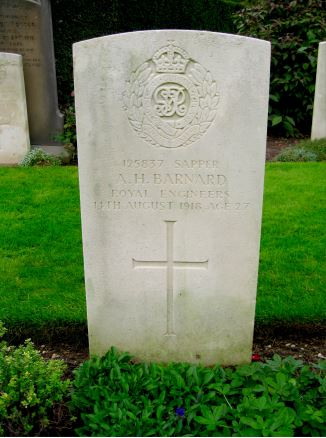Royal Engineers (Inland Water Transport)

(Abraham) Harold Barnard was born in Gloucester in early 1891. He was the son of Joseph William and Sarah Barnard, who by the time of the 1911 Census had had nine children, eight of who were surviving. The family lived at 9 Old Tram Road, Albion Street, Gloucester and J W Barnard was the manager of a firm of ship builders and repairers called G W Barnard, located at Monk Meadow Dock. In that census Harold was shown as an apprentice with the firm.
On 24 December 1914 Harold married Ada Houselander at Gloucester and they had a son, Ivor Harold, born on 12 October 1915.
Unusually at least part of Harold’s Army Service and Pension Records have survived. These reveal that he enlisted on 28 August 1916 at Gloucester and his occupation was noted as ‘shipwright’. It was stated that he had been with Messrs G W Barnard for 12 years, which probably equates from the time he left school. His residence was 15 Serlo Road, Gloucester but latterly this changed to 36 Seymour Road, Gloucester.
The Gloucester Journal of 24 August 1918, when reporting his funeral, states that before serving with the Army he had been a member of the City Fire Brigade and that upon joining the Army he was posted to Sandwich, Kent as a ship’s carpenter.
Harold was discharged from the Army, at Chatham, after 275 days service (on 29 May 1917), all in the UK, as ‘no longer physically fit for war service’. His primary medical condition was stated to be asthma, which had manifested itself in 1912 and was deemed to have been aggravated by ‘ordinary military service.’ Ongoing outpatient treatment was required and as a result he was granted a disability pension and awarded a Silver War Badge, to denote previous military service cut short on health grounds. Oddly his Service Record states that he was rated ‘fit for general service’, yet a medical board held at Shorncliffe Military Hospital on 28 April 1917 recorded ‘well-built lad: left foot badly deformed, right somewhat useless for marching or heavy work’. It does pose the question as to how and why he was accepted into the Army in the first place. His Discharge Sheet noted him to be of ‘very good character’, his conduct ‘very satisfactory’ and he ‘is a very good shipwright’.
The asthmatic condition appears, from medical reports, to have had detrimental side effects, one of which was a cardiac problem and it is possible that this was the cause of his death on 14 August 1918, age 27. The Gloucester Journal funeral report states that he had suffered a splinter wound in his hand, which required hospital treatment, prior to being discharged and had been in failing health since, however, there is nothing in the pension record to confirm this and it does seem likely that asthma was the underlying problem. His widow and family attended the funeral, which took place at Gloucester Cemetery, along with representatives of the various local fire brigades. His grave is now marked by a standard CWGC headstone. A Pension Record Card (released through Ancestry website in late 2018) stated his widow’s address to be 50 Theresa Street, Gloucester.
Researched by Graham Adams 23 December 2018 (revised)
